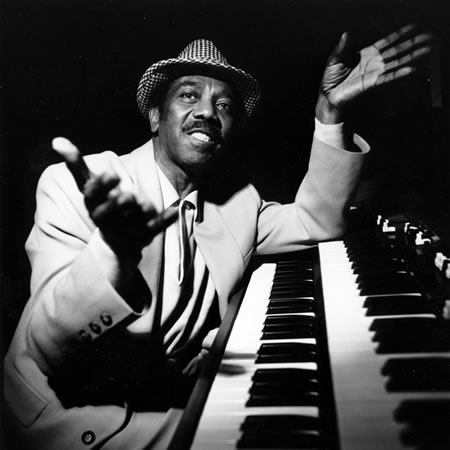
Jimmy Smith, master of the “Full Eights” sound on the mighty Hammond B-3!
Around 1985, the Yamaha Organ School was doing its damndest to expunge
my love for music and my sense of rhythm. While Yamaha’s musical
instrument division were practically redefining instruments — consider
the Yamaha grand piano’s bright sound, favoured by Glenn Gould and many
rock pianists, as well as the DX-7 synthesizer and the WX-7, which let
sax and clarinet players play synth — the ghouls behind the home organ
division crafted a course bereft of soul and full of schmaltz. I had a
teacher who had a bit of a legato fetish; she was an advocate of a
playing style in which the notes blurred together into a bland aural
mush. To make matters worse, I was only two out of fourteen songs
through the required Barry Manilow songbook.
After making sure that I got kicked out of organ school at the annual
recital (long story, which I’ll recount later), I became a synth player
full-time. I even went to far as to erase any of the organ sounds from
my Akai AX-60 synth. I’d had enough of that infernal instrument.
What changed my mind was a music course I took at Crazy Go Nuts
University: “Science and Technology for Musicians”. It qualified as an
“arts” course for engineering students and as a “science” course for
the music students. I often gave them a hand with the science parts
(“Uh, Joey, how do I draw a graph of a 5Hz sine wave with an amplitude
of 2?”) and they gave me a hand with non-keyboard instruments (“Uh,
Dave, how do I play a scale on a clarinet?”).
During the course, I wound up writing a paper on the Hammond B-3 organ.
This instrument was clearly the invention of a former watchmaker: a
classic Hammond is essentially a big electric motor driving a gear
system which in turn drives a series of wheels that made sound. While
writing the paper, I decided to hit the music library and listen to
artists who were considered B-3 virtuosos; that’s when I discovered
My bad experiences at the Yamaha Organ School, coupled with a teacher
who was more devoid of funk than the entire Michigan Militia, led me to
forget that one could play the organ with rhythm and even staccato
attacks. On the organ, Jimmy Smith’s hands and feet could be weapons;
his playing style defined what we now considered to be the de facto
organ soloing and pedalling style.
Musicians who redefine the way their
instrument is played tend to draw inspiration from other instruments. For example, Carlos Santana says that in order to perfect his signature guitar playing style, he played Dionne Warwick albums over and over and listened to her voice.
In Smith’s case, he drew inspiration from trumpet players, mimicking
their lines. He even emulated their sound in solos by killing the Leslie
(an organ spaker mounted on a rotating stand that gives organs their
“whirling” sound) and slamming every drawbar save the lowest and
highest to the “zero” setting.
After buying Jimmy’s live album, Root Down (whose name you should recognize — the Beastie Boys covered the title track on Ill Communication),
I reprogrammed the organ sounds back into my synth, and made sure than
any subsequent synth I bought could do a decent B-3 impression. Later,
when the organ made its comeback in rock in the early 1990’s (thanks
largely to the “Madchester” sound of bands like the Charlatans,
Inspiral Carpets, Milltown Brothers, et. al.), I copped more than my
fair share of Jimmy Smith licks at gigs. In 1994, I got to completely “Smith
out” when the band we opened for let me use their B-3 and Leslie. It
was heaven.
My last
synth — a Korg WaveStation A/D,
which I still have — has a patch I programmed: a monster B-3 sound
with a touch of distortion and a decent Leslie effect paired with
spring reverb. When you dial it up, its name appears in capital letters
on the display: JIMMY SMITH.
Jimmy Smith died on Tuesday at the age of 79. He’d been playing the organ for 50 years and would’ve embarked on a tour with Joey “The other keyboardist named Joey” deFrancesco next month.
Thanks, Jimmy, for all the music, and for helping me fall in love with the organ again.
6 replies on “RIP Jimmy Smith: 1926 – 2005”
That is a great tribute to the player and the hammond too!
Have you ever played with the Native Instruments B4 organ software?
http://www.native-instruments.com/index.php?b4_us
have to put on ‘green onions’ for a bit,
-E
Not to diminish the gravity of the occasion, but I simply cannot let it go without a teeny dig – too bad I’m flying up tomorrow and we won’t be spending the weekend in New England.
You know what? my mom babysat Carlos Santana like 40 or 45 years ago in Mexico. Isn’t that cool?
Nicely said. As for the redhead — those of us stuck with a weekend in New England don’t find it too bor(is)ing. That was one of manylows.
bnk
I saw Jimmy perform at Iriduim in NYC about a month ago. Very animated guy. Great set. RIP Jimmy
Jimmy was actually 76, and I recorded his gig right after his birthday in 2002 where he tells everyone how old he is.
my site is jamesoscarsmith.blogspot.com